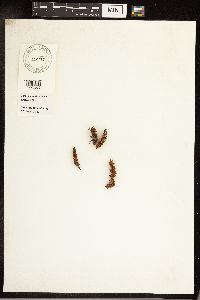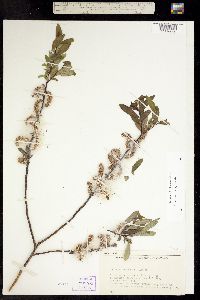
|
|
|
|
Family: Salicaceae
Park Willow, more...mountain willow
[Salix amelanchieroides L. Kelso, moreSalix barclayi var. cochetopiana L. Kelso, Salix barclayi var. neomexicana (E.H. Kelso) L. Kelso, Salix barclayi var. padophylla (Rydb.) L. Kelso, Salix barclayi var. resurrectionis L. Kelso, Salix barclayi var. uncompahgre L. Kelso, Salix barclayi var. veritomonticola L. Kelso, Salix cordata var. crux-aureae L. Kelso, Salix cordata var. monticola (Bebb) L. Kelso, Salix dissymetrica L. Kelso, Salix monticola var. neomexicana E.H. Kelso, Salix padifolia Rydb., non Anderss., Salix padophylla Rydb., Salix pseudomonticola var. padophylla (Rydb.) Ball, Salix sawatchicola L. Kelso] |
Plants 1.5-6 m. Stems: branches yellow-brown or red-brown mottled with green, not or weakly glaucous, glabrous; branchlets red-brown to yellow-brown, glabrous or puberulent, pilose, or villous, (buds caprea-type). Leaves: stipules foliaceous or rudimentary on early ones, foliaceous on late ones, apex acute or acuminate; petiole shallowly grooved, or convex to flat adaxially, 5.5-14 mm, pilose, villous, or velvety to glabrescent adaxially; largest medial blade (sometimes amphistomatous), narrowly oblong to oblong, narrowly elliptic to elliptic, lanceolate, oblanceolate, or obovate, 35-95 × 11-33 mm, 2-3.9 times as long as wide, base convex, rounded, or subcordate, margins slightly revolute or flat, serrulate, serrate, or sinuate, apex acute to acuminate, abaxial surface glaucous, glabrous, adaxial dull, glabrous or pilose, midrib pilose to villous; proximal blade margins entire or serrulate; juvenile blade sometimes reddish, villous or long-silky abaxially, hairs white, sometimes also ferruginous. Catkins: staminate flowering before or just before leaves emerge, pistillate as leaves emerge; staminate stout, 14-39 × 9-17 mm, flowering branchlet 0.5-7 mm; pistillate densely flowered, stout, 21-60 × 8-16 mm, flowering branchlet 0.5-8 mm; floral bract brown, black, or bicolor, 1-2 mm, apex rounded to acute, abaxially hairy, hairs wavy, straight, or curly. Staminate flowers: adaxial nectary narrowly oblong, 0.6-1.1 mm; filaments distinct or connate less than 1/2 their lengths, glabrous; anthers purple turning yellow, 0.4-0.8 mm. Pistillate flowers: adaxial nectary narrowly oblong, oblong, or flask-shaped, 0.4-1 mm, shorter than or equal to stipe; stipe 0.5-1.6 mm; ovary pyriform, glabrous, beak gradually tapering to styles; ovules 11-15 per ovary; styles 0.6-1.1 mm; stigmas flat, abaxially non-papillate with rounded tip, or broadly cylindrical, 0.24-0.36-0.56 mm. Capsules 4-7 mm. 2n = 114. Flowering late Apr-early Jul. Streams, cienegas, meadows, springs; 1700-3500 m; Ariz., Colo., N.Mex., Utah, Wyo. Plant: shrub; to 6 m tall; branches yellow- or red-brown, glabrous; branchlets yellow- or red-brown, glabrous or villous Leaves: petioles villous, 5.5-14 mm long; proximal leaves on vegetative or flowering branchlets gland-dotted or serrulate; young leaves villous or silky; mature blade oblong, narrowly elliptic to lanceolate, or oblanceolate to obovate, 35-95 mm long 11-33 mm wide, 2-3.9 times as long as wide, the lower surface glaucous, glabrous; upper surface dull, glabrous or pilose, especially on midrib, the base acute to rounded, the margins slightly revolute to flat, serrulate to serrate, with 5-9 teeth per cm, the apex acute to subacuminate INFLORESCENCE: cylindrical to subspherical catkins; precocious, subprecocious, or coetaneous; floral bracts brown, black, or bicolored, 1.4-2 mm long, with curly or straight hairs, the apices rounded to acute Flowers: STAMINATE FLOWERS in densely flowered catkins 10-37 mm long; flowering branchlets 0-3 mm long; stamens 2, the filaments hairy; nectary slender, 0.6-0.9 mm long. PISTILLATE FLOWERS in densely flowered catkins 15-57 mm long; flowering branchlets 0-8 mm long; ovaries glabrous; stigmas 0.24-0.56 mm long; styles 0.6-1.1 mm long; stipes 0.6-1.6 mm long; nectary slender to broad, 0.4-1 mm long, shorter than or equal to stipe Fruit: lanceolate to ovate Misc: Subalpine to montane; thickets along rivers and creeks, cienegas, meadows and springs; 2200-3100 m (6900-9500 ft);; May REFERENCES: Argus, George W. 1995. SalicaceaePart 2. Salix. J. Ariz. - Nev. Acad. Sci. 29(1): 39 |
|
|
|
This project was made possible in part by the Institute of Museum and Library Services [MG-70-19-0057-19].
Powered by Symbiota






































































































